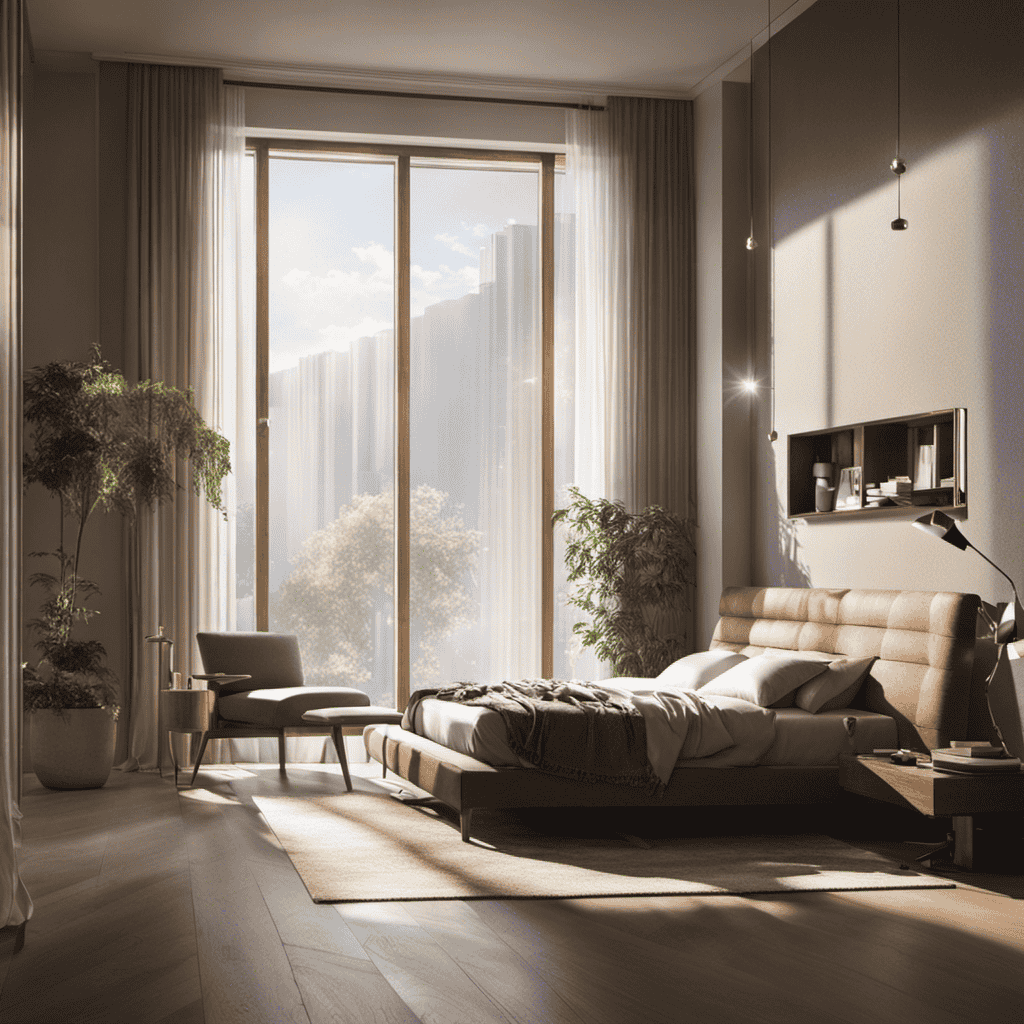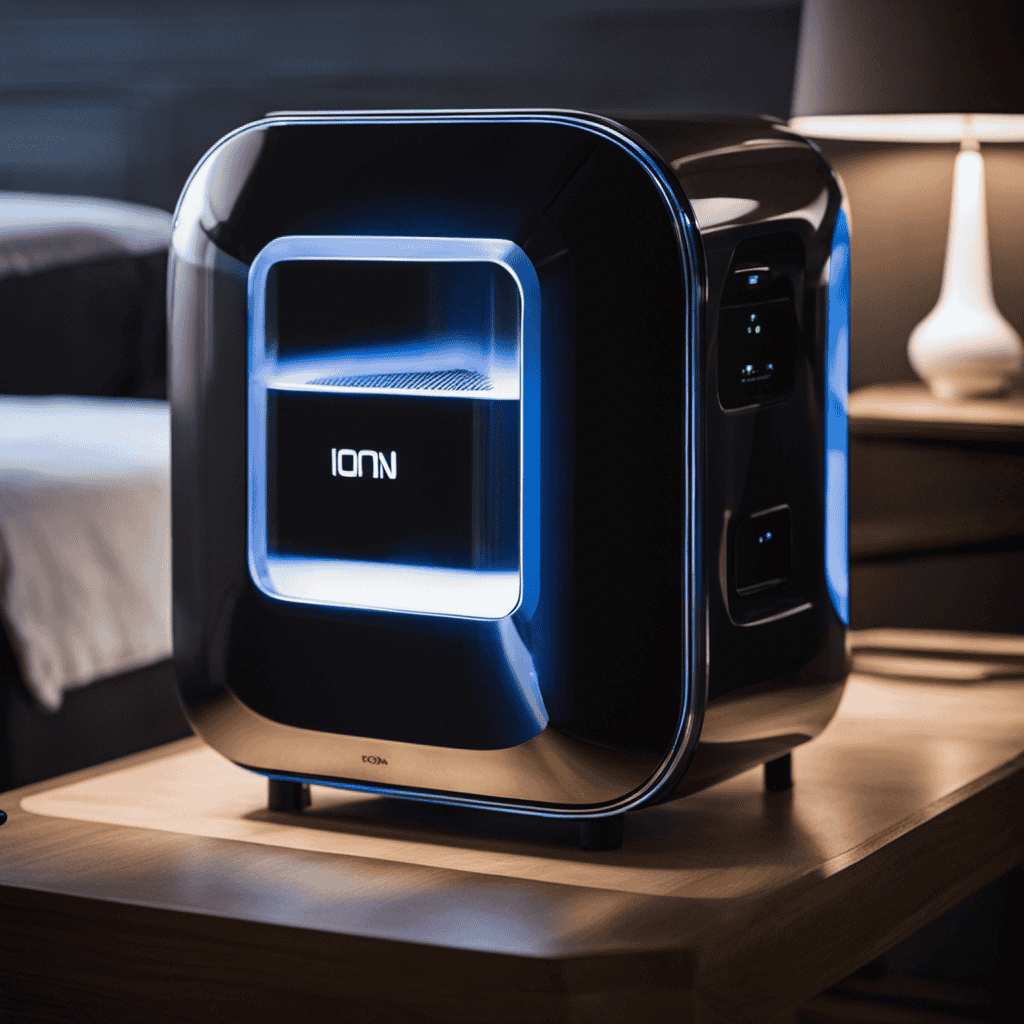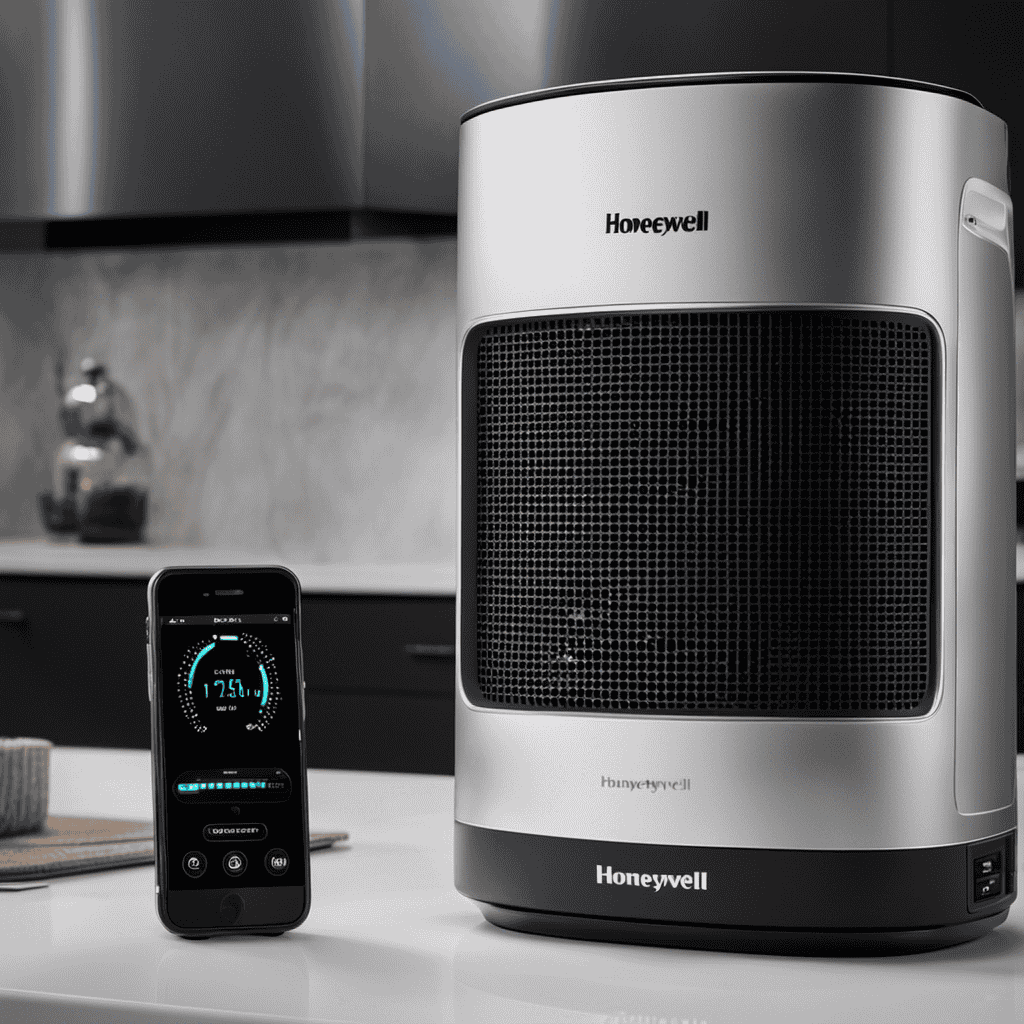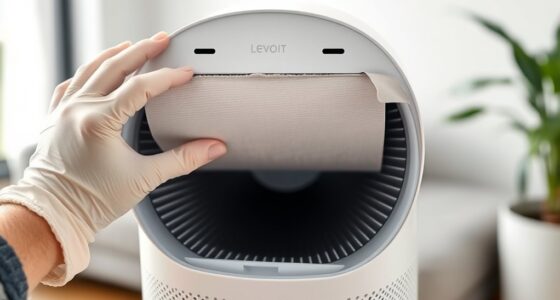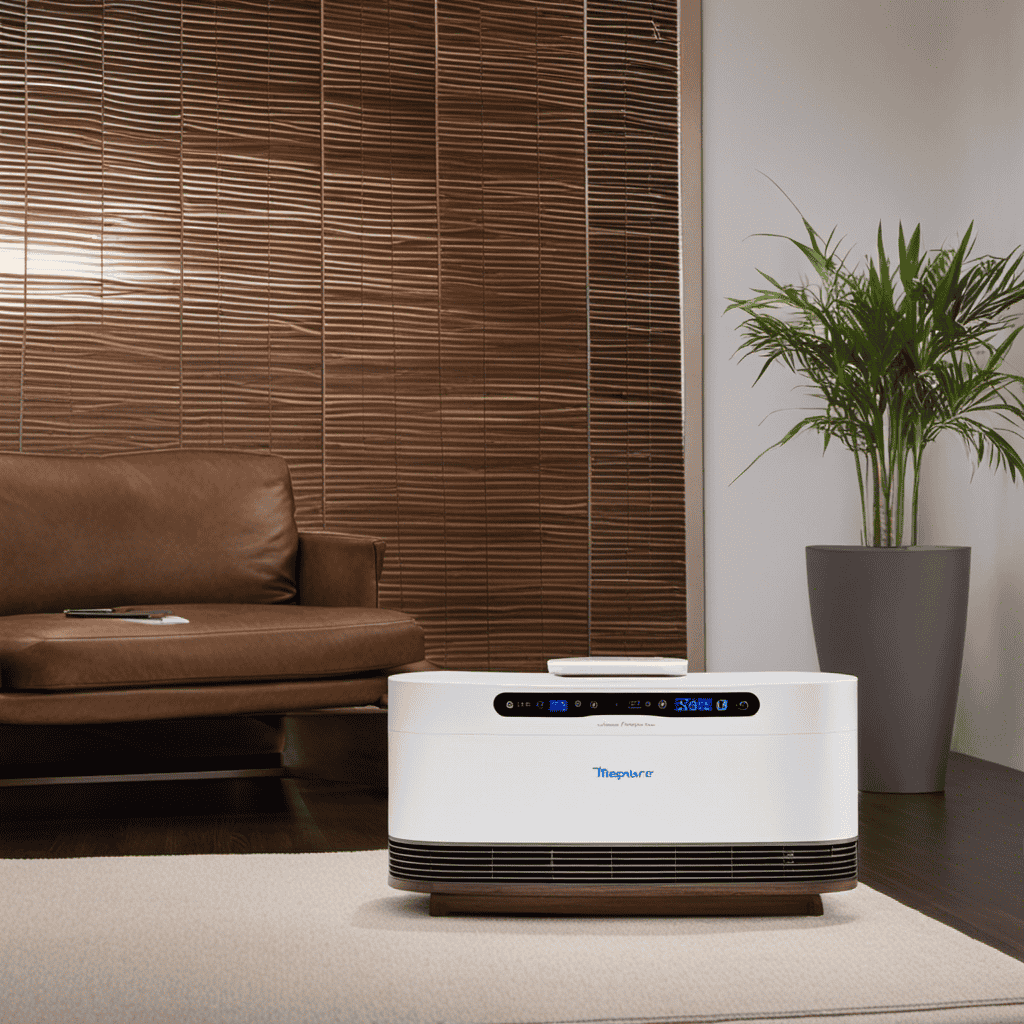As someone who prioritizes health, I frequently contemplate how to enhance the indoor air quality. This is where the air purifier becomes essential.
This remarkable device is like a shield, tirelessly working to eliminate harmful pollutants and allergens from the air, creating a healthier and more comfortable living environment.
But why do I need an air purifier, you may ask? Well, in this article, we’ll delve into the fascinating world of air purification and uncover the numerous benefits it offers.
So, let’s dive in and discover why an air purifier is a must-have for every home.
Key Takeaways
- Air purifiers can help reduce the risk of allergies and respiratory issues by capturing and trapping airborne particles like dust, pollen, pet dander, and mold spores.
- Regular maintenance of air purifiers is crucial for optimal performance and to avoid decreased performance and the emission of harmful particles.
- Air purifiers improve indoor air quality by removing harmful gases and odors using technologies like UV light or activated carbon filters.
- Air purifiers are highly effective in reducing allergens and improving indoor air quality, providing relief for allergies and asthma symptoms.
Health Benefits of Using an Air Purifier
Using an air purifier can help you breathe cleaner air and reduce the risk of allergies and respiratory issues. Contrary to common misconceptions, air purifiers are not just a luxury item, but rather an essential device for maintaining good indoor air quality.
Regular maintenance of your air purifier is crucial to ensure its optimal performance. Cleaning or replacing the filters regularly is necessary to remove pollutants effectively. Additionally, keeping the air purifier in a well-ventilated area and away from obstructions will maximize its efficiency. Neglecting proper maintenance can lead to a decrease in performance and may even cause the air purifier to emit harmful particles into the air.
Now that we understand the importance of air purifier maintenance, let’s explore common indoor air pollutants and their effects.
Common Indoor Air Pollutants and Their Effects
To understand the importance of an air purifier, it’s crucial for you to be aware of the common indoor air pollutants and how they can affect your health. Indoor pollution can have a significant impact on your respiratory system, leading to various health issues. Here is a table highlighting some common indoor air pollutants and their effects on our health:
| Indoor Air Pollutant | Effects on Health |
|---|---|
| Tobacco smoke | Irritation of the eyes, nose, and throat; increased risk of respiratory infections |
| Dust mites | Allergies, asthma attacks |
| Mold spores | Allergic reactions, respiratory infections |
| Pet dander | Allergic reactions, asthma attacks |
| Volatile organic compounds (VOCs) | Eye, nose, and throat irritation; headaches; dizziness |
As you can see, these pollutants can have detrimental effects on our health, especially for those with respiratory conditions or allergies. Transitioning to the next section, let’s explore how air purifiers can improve indoor air quality and alleviate these issues.
How Air Purifiers Improve Indoor Air Quality
By removing common indoor air pollutants, an air purifier can significantly improve the quality of the air you breathe in your home. Research has shown that air purifiers are effective in reducing indoor air pollution and promoting a healthier living environment.
Here are five ways in which air purifiers work to improve indoor air quality:
-
Filtering: Air purifiers use filters to capture and trap airborne particles such as dust, pollen, pet dander, and mold spores.
-
Purifying: Some air purifiers are equipped with technologies like UV light or activated carbon filters to remove harmful gases and odors.
-
Circulating: Air purifiers circulate the air in a room, ensuring that all the air is filtered and purified.
-
Reducing Allergens: Air purifiers can help reduce allergens in the air, providing relief for those with allergies and asthma.
-
Enhancing Sleep: Cleaner air can promote better sleep by reducing irritants that can cause discomfort during the night.
With their effectiveness in combating indoor air pollution, air purifiers are an essential tool for creating a healthier home environment.
Now, let’s explore how air purifiers can specifically help with allergies and asthma.
Allergies and Asthma: How an Air Purifier Can Help
If you suffer from allergies and asthma, an air purifier can provide relief by reducing allergens in the air you breathe. Allergies and asthma are both conditions that can be triggered by airborne allergens such as dust mites, pollen, pet dander, and mold spores. These allergens can cause symptoms like sneezing, wheezing, coughing, and itchy eyes.
An air purifier works by filtering the air and trapping these allergens, preventing them from circulating in your home. Research has shown that air purifiers can be highly effective in reducing allergens and improving indoor air quality. They can remove up to 99.97% of airborne particles as small as 0.3 microns. This can significantly reduce the allergens in your home, providing relief and preventing allergy symptoms.
Therefore, investing in an air purifier can be a valuable tool for allergy prevention and managing asthma symptoms.
Eliminating Odors With an Air Purifier
Eliminating odors is one of the benefits you’ll experience when using an air purifier. Not only does it improve the air quality in your home, but it also creates a more pleasant and fresh environment.
Here are some reasons why an air purifier is effective in odor elimination and air freshening:
-
Activated Carbon Filter: This filter is designed to trap and remove odors, gases, and chemicals from the air, effectively neutralizing unpleasant smells.
-
HEPA Filtration: High-Efficiency Particulate Air (HEPA) filters can capture tiny particles as small as 0.3 microns, including odor-causing particles like pet dander, pollen, and mold spores.
-
Odor Sensors: Some advanced air purifiers come with odor sensors that detect and automatically adjust the cleaning speed to remove odors more efficiently.
-
Ionizers: These devices release negative ions that attach to and eliminate airborne particles, including odor molecules.
-
Ozone Generators: While controversial, ozone generators can help eliminate odors by breaking down odor-causing molecules.
The Link Between Air Pollution and Respiratory Diseases
I’ve always been concerned about the health risks associated with pollution, especially when it comes to respiratory diseases.
With the prevalence of respiratory diseases on the rise, it’s crucial to understand the link between air pollution and these conditions.
Thankfully, using an air purifier can help mitigate some of these risks by removing harmful pollutants from the air we breathe.
Health Risks of Pollution
The health risks of pollution can be reduced by using an air purifier. Air pollution is a major concern worldwide due to its detrimental effects on human health. Here are some key reasons why using an air purifier is essential for air pollution control:
-
Removes harmful pollutants: An air purifier effectively filters out pollutants such as dust, pollen, pet dander, and smoke, improving indoor air quality.
-
Reduces respiratory symptoms: By eliminating allergens and irritants, an air purifier can help alleviate symptoms of asthma, allergies, and other respiratory conditions.
-
Minimizes the risk of cardiovascular diseases: Air pollution is linked to an increased risk of heart attacks, strokes, and other cardiovascular issues. A purifier reduces exposure to pollutants, thus lowering these risks.
-
Enhances sleep quality: Cleaner air promotes better sleep by reducing congestion and improving breathing.
-
Protects against long-term health effects: Prolonged exposure to pollutants can lead to chronic respiratory diseases, lung cancer, and other serious health issues. Using an air purifier can help minimize these risks.
Reducing the health risks of pollution is crucial, especially considering the prevalence of respiratory diseases.
Respiratory Diseases Prevalence
To reduce the prevalence of respiratory diseases, you can take steps to improve indoor air quality.
Indoor air pollution, caused by a variety of sources such as cooking, smoking, and the use of certain cleaning products, has a significant impact on our respiratory health. Poor indoor air quality can lead to the development or exacerbation of respiratory conditions such as asthma, bronchitis, and allergies.
Studies have shown that exposure to indoor air pollution can increase the risk of respiratory infections and worsen symptoms in individuals with pre-existing respiratory conditions. It is important to be aware of the impact of air pollution on our respiratory health and to take measures to minimize exposure.
Using air purifiers and ensuring proper ventilation are effective ways to improve indoor air quality and reduce the risk of respiratory diseases.
Air Purifier Benefits
Using an air purifier can greatly improve indoor air quality and reduce the risk of respiratory diseases. Air purifiers are highly effective in removing harmful pollutants and allergens from the air we breathe.
Here are some key benefits of using an air purifier:
-
Removes airborne particles: Air purifiers can effectively filter out dust, pollen, pet dander, and other airborne particles, providing cleaner and healthier air.
-
Eliminates odors: These devices are equipped with activated carbon filters that can remove unpleasant odors, such as cooking smells, pet odors, and cigarette smoke.
-
Reduces allergy symptoms: Air purifiers can help alleviate allergy symptoms by removing allergens like pollen and dust mites, providing relief to individuals suffering from allergies.
-
Traps harmful gases: Some air purifiers are designed to capture and neutralize harmful gases, such as volatile organic compounds (VOCs) and formaldehyde, improving overall indoor air quality.
-
Easy maintenance: Regular maintenance, such as cleaning or replacing filters, ensures the continued effectiveness of the air purifier and prolongs its lifespan.
Air Purifiers Vs. Ventilation Systems: Which Is Better
Did you know that air purifiers and ventilation systems have different benefits and it’s important to understand which one is better for your specific needs? While both options aim to improve indoor air quality, they work in different ways. Ventilation systems bring fresh air into the space, removing stale air and odors. This can help reduce the buildup of pollutants and maintain a healthy environment. On the other hand, air purifiers are designed to filter and purify the air by removing microscopic particles, such as dust, pollen, and pet dander. They can effectively capture contaminants that may cause allergies or respiratory issues. To help you better understand the differences, here is a comparison table:
| Ventilation Systems | Air Purifiers | |
|---|---|---|
| Benefits | Removes stale air and odors | Filters and purifies air, removes microscopic particles |
| Effectiveness | Helps maintain fresh air, reduces pollutant buildup | Effectively captures and removes allergens and contaminants |
| Cost | Initial installation cost, ongoing maintenance | Initial cost, periodic filter replacement |
| Coverage | Whole-house or specific areas | Specific rooms or areas |
Choosing the Right Air Purifier for Your Home
When considering which air cleaning device is best for your home, it’s important to choose the one that meets your specific needs.
Here are some key features to look for in an air purifier:
- True HEPA filter: This type of filter is highly effective at capturing small particles, including allergens and pollutants.
- Activated carbon filter: This filter helps to remove odors and chemicals from the air.
- UV-C light: This feature can help kill bacteria and viruses that may be present in the air.
- Air quality sensor: An air purifier with this feature can automatically adjust its settings based on the air quality in your home.
- Filter replacement indicator: This indicator will let you know when it’s time to replace the filters, ensuring optimal performance.
Regular air purifier maintenance is also important to keep your device functioning properly. This includes regularly cleaning or replacing the filters, as well as cleaning the exterior of the unit.
Understanding these air purifier features and maintenance requirements will help you choose the right device for your home and ensure clean, healthy air for you and your family.
In the subsequent section, we will delve into understanding different types of air purification technologies and how they work to improve indoor air quality.
Understanding Different Types of Air Purification Technologies
There are various types of technologies that can improve indoor air quality. When it comes to air purification, understanding the different technologies available is crucial.
One popular technology is High-Efficiency Particulate Air (HEPA) filtration, which can capture particles as small as 0.3 microns.
Another option is activated carbon filtration, which is effective in removing odors and chemicals from the air.
Ultraviolet germicidal irradiation (UVGI) technology uses UV-C light to kill bacteria and viruses.
Electrostatic precipitators use an electric charge to capture particles, while ionizers release negatively charged ions to attract and remove pollutants.
Each technology has its own advantages and disadvantages, so it’s important to consider factors like maintenance requirements and the specific needs of your indoor environment when comparing air purification technologies.
Regular air purifier maintenance, such as cleaning or replacing filters, is also essential for optimal performance and longevity.
The Importance of Regular Maintenance for Air Purifiers
You should regularly maintain your air purification system to ensure optimal performance and longevity. Proper maintenance not only helps to keep the air in your home clean and fresh, but it also extends the lifespan of your air purifier. Here are some important air purifier maintenance tips:
-
Change air filters regularly: The air filters in your purifier trap dust, pollen, and other particles, but they can become clogged over time. Changing them regularly ensures that your purifier can continue to effectively filter the air.
-
Clean the exterior: Dust and debris can accumulate on the exterior of your air purifier, hindering its performance. Regularly wipe down the surfaces to keep it clean.
-
Check the pre-filter: Some air purifiers have pre-filters that capture larger particles. Check and clean or replace them as needed.
-
Clean the fan and vents: Dust can accumulate on the fan and vents, reducing airflow. Clean them with a soft brush or vacuum attachment.
-
Schedule professional maintenance: Consider scheduling professional maintenance once a year to ensure that all components are working properly.
Air Purifiers and Pet Dander: Keeping Your Home Allergy-Free
As a pet owner with allergies, I understand the challenges of keeping a home allergy-free.
Pet dander is a common allergen that can cause sneezing, wheezing, and other respiratory symptoms.
In this discussion, we will explore effective solutions for managing pet allergies and the benefits of using air purifiers to remove pet dander from the air, creating a healthier living environment.
Pet Allergies and Solutions
If you have pet allergies, an air purifier can help alleviate your symptoms.
As someone who suffers from pet allergies myself, I understand the importance of finding effective solutions.
Here are some key points to consider when it comes to pet allergies and solutions:
-
Pet dander control: Pet dander, which is composed of tiny skin flakes, is a common allergen. An air purifier with a HEPA filter can capture and remove pet dander from the air, reducing your exposure to it.
-
Hypoallergenic pets: While no pet is truly hypoallergenic, certain breeds are known to produce fewer allergens. If you’re considering getting a pet, research hypoallergenic breeds such as poodles, bichon frises, or sphynx cats.
-
Regular grooming: Regularly grooming your pet can help reduce the amount of dander they produce. Brushing their fur and bathing them regularly can help minimize allergens in your home.
-
Cleaning habits: Regularly cleaning your home can also make a difference. Vacuuming with a HEPA filter, washing bedding frequently, and using allergen-proof covers on mattresses and pillows can help reduce allergen exposure.
-
Consultation with a doctor: If you have severe pet allergies, it’s important to consult with a doctor for personalized advice and treatment options.
Benefits of Air Purification
The benefits of using an air purifier include reducing allergens in the air and creating a cleaner environment.
Research shows that air purifiers can effectively capture and remove common allergens such as dust mites, pollen, and pet dander. By reducing these allergens, air purifiers can improve indoor air quality and help alleviate symptoms for individuals with allergies or asthma.
Furthermore, cleaner air can lead to improved productivity and fewer sick days. Studies have found that poor indoor air quality can negatively impact cognitive function and increase the risk of respiratory illnesses. By using an air purifier, you can create a healthier environment that promotes well-being and reduces the likelihood of illness.
In the next section, we will explore how air purifiers can also help reduce the spread of airborne viruses.
How Air Purifiers Can Reduce the Spread of Airborne Viruses
Using an air purifier can help you reduce the spread of airborne viruses. Air purifiers are equipped with filters that can capture and remove harmful particles, including viruses, from the air. Here are some ways air purifiers can be effective in reducing the spread of airborne viruses:
-
Filtration: Air purifiers use HEPA filters that can trap particles as small as 0.3 microns, including viruses.
-
Disinfection: Some air purifiers are equipped with UV-C lights that can kill viruses and bacteria.
-
Air circulation: Air purifiers help in circulating and filtering the air in a room, reducing the concentration of viruses.
-
Humidity control: Some air purifiers have built-in humidifiers that can help maintain optimal humidity levels, making the air inhospitable for viruses.
-
Energy consumption: Look for air purifiers with energy-efficient features to minimize energy consumption and reduce electricity bills.
Improving Sleep Quality With an Air Purifier
When it comes to improving sleep quality, an air purifier can provide numerous benefits.
Firstly, it helps in reducing allergens in the air, such as dust mites, pollen, and pet dander, which can trigger allergies and disrupt sleep.
Secondly, an air purifier decreases respiratory irritation by removing pollutants like smoke, chemicals, and volatile organic compounds, creating a healthier environment for breathing.
Lastly, it eliminates sleep disruptors like odors and airborne bacteria, helping to create a clean and fresh sleeping space conducive to a good night’s rest.
Allergen Reduction Benefits
One major benefit of an air purifier is that it can help reduce allergens in your home. As someone who suffers from allergies, I understand the importance of creating a clean and healthy indoor environment.
Here are some ways in which an air purifier can effectively reduce allergens:
-
Filtration: Air purifiers use filters to trap allergens such as dust, pollen, pet dander, and mold spores, preventing them from circulating in the air.
-
HEPA Technology: High Efficiency Particulate Air (HEPA) filters are capable of capturing particles as small as 0.3 microns, ensuring cleaner and allergen-free air.
-
Ionization: Some air purifiers release negatively charged ions that attach to allergens, causing them to fall out of the air and onto surfaces.
-
UV-C Light: Air purifiers with UV-C light can kill airborne bacteria, viruses, and mold spores, further reducing allergens in your home.
-
Regular Maintenance: Keeping your air purifier clean and changing filters regularly is essential to maintain its effectiveness in reducing allergens.
By implementing these allergen reduction techniques and ensuring proper air purifier maintenance, you can create an environment that is much more comfortable for allergy sufferers like myself.
As a result, you can experience decreased respiratory irritation and enjoy a healthier living space.
Decreased Respiratory Irritation
To decrease respiratory irritation, you’ll find relief by implementing these allergen reduction techniques and maintaining your air purifier regularly.
Air purifiers offer numerous benefits for respiratory health. They help eliminate airborne allergens such as dust mites, pollen, pet dander, and mold spores, which are common triggers for respiratory allergies and asthma. By removing these irritants from the air, air purifiers can significantly reduce respiratory symptoms such as coughing, wheezing, sneezing, and congestion.
Additionally, air purifiers can also filter out harmful pollutants like smoke, volatile organic compounds (VOCs), and bacteria, further improving indoor air quality.
Regular maintenance of your air purifier, including cleaning or replacing filters and ensuring proper ventilation, is crucial to maximize its effectiveness in reducing respiratory irritation.
Eliminating Sleep Disruptors
Get a good night’s sleep by eliminating sleep disruptors such as excessive noise, bright lights, and electronic devices in your bedroom. These disruptors can negatively impact your sleep quality, leading to daytime drowsiness, difficulty concentrating, and even increased snoring.
By creating a sleep-friendly environment, you can improve your concentration during the day and reduce snoring at night. Here are some ways to eliminate sleep disruptors:
- Use earplugs or white noise machines to block out excessive noise.
- Install blackout curtains or use an eye mask to eliminate bright lights.
- Set a digital curfew and keep electronic devices out of the bedroom.
- Invest in a comfortable mattress and pillows for optimal sleep quality.
- Practice relaxation techniques, such as meditation or deep breathing, to calm your mind before bed.
By implementing these strategies, you can create a peaceful and restful sleep environment, improving your concentration and reducing snoring.
Transitioning to the next section, let’s explore how air purifiers can help protect your family’s health from secondhand smoke.
Air Purifiers and Secondhand Smoke: Protecting Your Family’s Health
You need an air purifier to protect your family’s health from secondhand smoke. As a parent, I understand the importance of protecting children from the harmful effects of secondhand smoke. It’s not just the smell that bothers me, but the fact that it can lead to serious respiratory problems and increase the risk of lung cancer. Research has shown that exposure to secondhand smoke can cause asthma, bronchitis, and even sudden infant death syndrome (SIDS). To illustrate the impact of secondhand smoke, I have created a table below:
| Health Risks | Effects on Children |
|---|---|
| Asthma | Increased risk of asthma attacks |
| Respiratory Infections | More frequent colds and infections |
| Ear Infections | Higher chance of developing ear infections |
| SIDS | Increased risk of SIDS |
Investing in an air purifier can help eliminate the harmful particles and chemicals present in secondhand smoke, providing a safer environment for your family. It’s a small step that can have a big impact on your loved ones’ health.
The Cost-Effectiveness of Using an Air Purifier in the Long Run
When considering the cost-effectiveness of using an air purifier in the long run, it’s important to take into account the potential for long-term savings.
While air purifiers may require an initial investment, they can lead to significant savings by improving indoor air quality and reducing the risk of health issues associated with poor air quality.
In addition to the financial benefits, the health benefits that come with using an air purifier outweigh the costs, as cleaner air can help prevent respiratory problems and other health conditions.
Long-Term Savings Potential
Investing in an air purifier can save you money in the long run by reducing the need for frequent visits to the doctor due to respiratory issues. Not only does it improve the air quality in your home, but it also has long-term savings potential.
Here are some key reasons why:
- Air purifier maintenance is relatively low, requiring only regular filter replacements and occasional cleaning.
- Energy efficiency is an important feature of modern air purifiers, helping to minimize electricity costs.
- By removing harmful pollutants and allergens from the air, air purifiers can prevent respiratory problems and reduce the need for medication.
- Improved indoor air quality can lead to better sleep, increased productivity, and reduced sick days, resulting in overall cost savings.
- Air purifiers can extend the lifespan of furniture, electronics, and appliances by reducing the buildup of dust and other particles.
Investing in an air purifier is a smart decision that can lead to long-term savings while improving your overall health and well-being.
Health Benefits Outweigh Costs
The health benefits of an air purifier outweigh the costs due to its ability to improve indoor air quality and reduce respiratory issues.
Numerous studies have shown that indoor air can be significantly more polluted than outdoor air, with harmful pollutants like dust, pollen, pet dander, and volatile organic compounds (VOCs) present in higher concentrations. Breathing in these pollutants can lead to various respiratory issues such as allergies, asthma, and even more serious conditions like chronic obstructive pulmonary disease (COPD).
An air purifier effectively filters out these pollutants, removing them from the air and creating a cleaner and healthier indoor environment.
While the initial cost of purchasing and maintaining an air purifier may seem like a financial burden, the long-term health benefits and potential cost savings from reduced medical expenses make it a highly cost-effective investment.
Air Quality Improvement
There are several ways to improve indoor air quality without using an air purifier. While air purifiers are effective at removing pollutants, there are alternative methods to enhance air quality.
- Regularly clean and vacuum your home to reduce dust accumulation.
- Use natural cleaning products to minimize the release of harmful chemicals.
- Keep windows and doors open to allow fresh air to circulate.
- Install and maintain proper ventilation systems to ensure air flow.
- Monitor air quality using devices such as carbon dioxide detectors and particulate matter sensors.
By implementing these measures, you can maintain a healthier indoor environment without relying solely on air purifiers.
Additionally, proper air purifier maintenance is crucial to ensure optimal performance. Regularly clean or replace filters, and follow manufacturer guidelines for maintenance tasks. Regular air quality monitoring can also help identify any potential issues and allow for prompt action to improve the air you breathe.
Frequently Asked Questions
How Do Air Purifiers Work to Improve Indoor Air Quality?
Air purifiers improve indoor air quality by removing pollutants like dust, allergens, and pet dander. They work by pulling in air, filtering it through a series of filters, and then releasing cleaner air. Regular maintenance ensures their effectiveness.
Can Air Purifiers Completely Eliminate All Indoor Air Pollutants?
Air purifiers can greatly reduce indoor air pollution, but they cannot completely eliminate all pollutants. While they are effective at capturing and removing many contaminants, some particles may still remain in the air.
Are There Any Potential Health Risks Associated With Using an Air Purifier?
There may be potential side effects of using an air purifier, such as dryness or irritation of the respiratory system. However, these effects are generally mild and temporary, without any significant long-term impact on health.
Do Air Purifiers Need to Be Constantly Running to Be Effective?
To effectively maintain an air purifier, it is beneficial to run it continuously. This ensures a constant flow of clean air and maximizes its efficiency in removing pollutants and allergens from the environment.
Can Air Purifiers Help Reduce the Symptoms of Respiratory Illnesses Like Asthma and Allergies?
Air purifiers have been shown to reduce respiratory symptoms in people with asthma and allergies, improving sleep quality. They can also help alleviate pet allergies by removing pet dander and other allergens from the air.
Conclusion
After researching the benefits of using an air purifier, I have come to a surprising conclusion. Who needs fresh air anyway?
Breathing in pollutants and allergens on a daily basis adds excitement to life, doesn’t it? Forget about improving sleep quality, reducing the spread of viruses, or protecting your family’s health. Let’s embrace the pungent odors and respiratory issues.
Who needs an air purifier when we can live in a toxic cloud of uncertainty? Irony aside, investing in an air purifier is a smart and essential choice for a healthier and cleaner environment.
